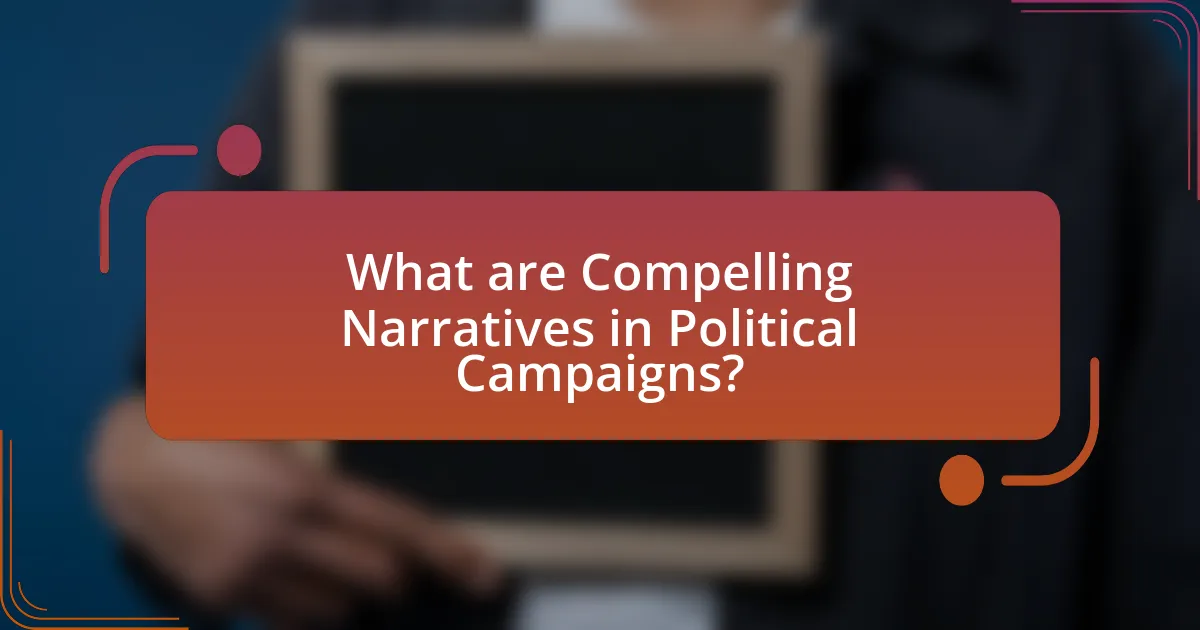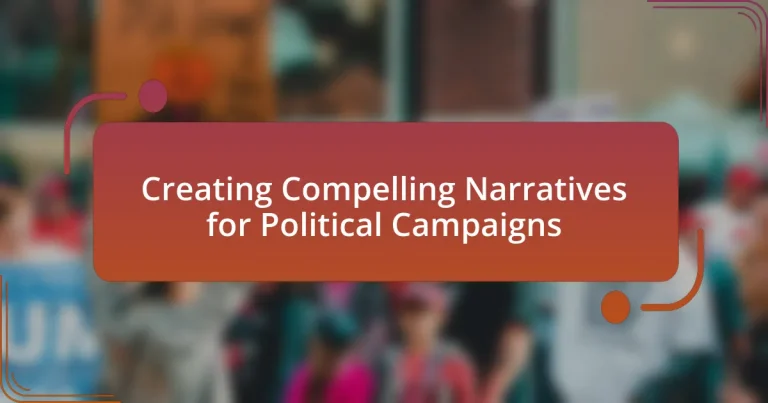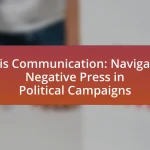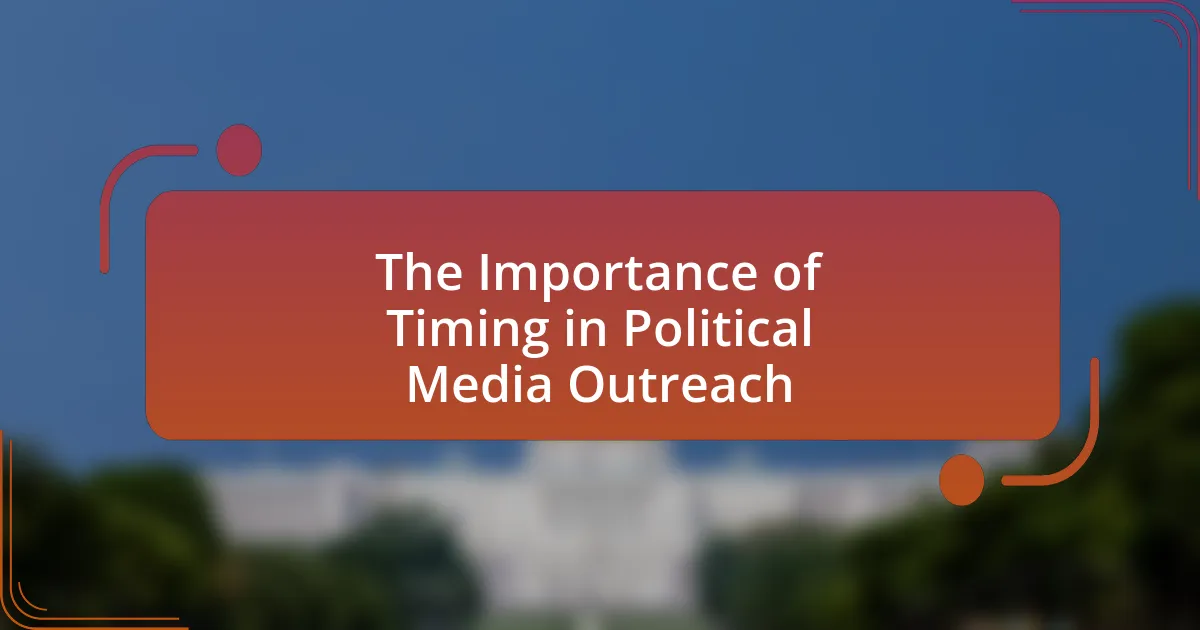Creating compelling narratives for political campaigns involves crafting structured stories that resonate emotionally with voters, effectively communicating a candidate’s values and policies. The article explores how these narratives influence voter perception, enhance candidate identity, and mobilize engagement and turnout. It discusses the psychological factors that make narratives persuasive, the essential elements of effective storytelling, and the importance of authenticity and data in narrative development. Additionally, it outlines strategies for crafting, implementing, and communicating narratives while highlighting common pitfalls to avoid, ensuring that political campaigns can effectively connect with their audience and drive electoral support.

What are Compelling Narratives in Political Campaigns?
Compelling narratives in political campaigns are structured stories that resonate emotionally with voters, effectively conveying a candidate’s values, vision, and policies. These narratives often include personal anecdotes, relatable experiences, and clear messaging that align with the audience’s beliefs and aspirations. For instance, Barack Obama’s 2008 campaign utilized the narrative of hope and change, which connected deeply with voters seeking a transformative leader during a time of economic crisis. This approach not only humanized the candidate but also fostered a sense of collective identity among supporters, demonstrating the power of storytelling in mobilizing electoral support.
How do compelling narratives influence voter perception?
Compelling narratives significantly influence voter perception by shaping how individuals understand political issues and candidates. These narratives create emotional connections, making complex topics more relatable and memorable. For instance, research by the Pew Research Center indicates that voters are more likely to engage with candidates who present their policies through personal stories or relatable experiences, as these narratives foster empathy and trust. Furthermore, compelling narratives can frame issues in a way that aligns with voters’ values, leading to increased support. A study published in the Journal of Communication found that narratives that resonate with a voter’s identity can enhance their likelihood of voting for a candidate, demonstrating the power of storytelling in political contexts.
What psychological factors make narratives persuasive?
Narratives are persuasive due to psychological factors such as emotional engagement, identification, and cognitive ease. Emotional engagement occurs when narratives evoke feelings, making the audience more receptive to the message. Identification happens when individuals see themselves in the story, fostering a personal connection that enhances persuasion. Cognitive ease refers to the ease with which information is processed; simple, relatable narratives are easier to understand and remember, increasing their persuasive power. Research by Green and Brock (2000) in “The Role of Transportation in the Persuasiveness of Public Narratives” demonstrates that individuals who are “transported” into a narrative are more likely to change their attitudes and beliefs, highlighting the effectiveness of these psychological factors in persuasive storytelling.
How do narratives shape the identity of a political candidate?
Narratives shape the identity of a political candidate by framing their values, experiences, and vision in a way that resonates with voters. These narratives create a cohesive story that helps candidates connect emotionally with their audience, influencing public perception and voter behavior. For instance, Barack Obama’s narrative of hope and change during the 2008 election effectively positioned him as a transformative leader, which was supported by his personal story of overcoming adversity and advocating for unity. This narrative not only defined his identity but also mobilized a diverse coalition of supporters, demonstrating the power of storytelling in political campaigns.
Why are narratives essential for political campaigns?
Narratives are essential for political campaigns because they shape the way voters perceive candidates and their messages. A well-crafted narrative can create emotional connections, making complex political issues relatable and understandable. For instance, studies show that candidates who effectively use storytelling techniques can increase voter engagement and support; a 2016 analysis by the Pew Research Center found that 63% of voters felt more connected to candidates who shared personal stories. This connection can significantly influence voter behavior, as narratives help to humanize candidates and clarify their positions on key issues.
What role do narratives play in differentiating candidates?
Narratives play a crucial role in differentiating candidates by shaping their identities and resonating with voters’ values and experiences. Effective narratives allow candidates to present their unique perspectives, highlight their personal stories, and connect emotionally with the electorate, which can significantly influence voter perception and decision-making. For instance, a candidate who shares a compelling personal journey related to overcoming adversity may stand out compared to others who do not convey such relatable experiences. This differentiation is supported by research indicating that voters are more likely to engage with candidates whose narratives align with their own beliefs and aspirations, thus enhancing the candidate’s appeal and likelihood of electoral success.
How can narratives mobilize voter engagement and turnout?
Narratives can mobilize voter engagement and turnout by creating emotional connections and relatable stories that resonate with individuals’ values and experiences. When political campaigns utilize compelling narratives, they can effectively highlight issues that matter to voters, making the electoral process feel more relevant and urgent. For instance, research by the Pew Research Center indicates that voters are more likely to participate in elections when they feel personally connected to the issues at stake, which narratives can facilitate by humanizing complex political topics. Additionally, narratives can inspire action by showcasing the impact of voting through stories of individuals who have made a difference, thereby motivating others to engage in the electoral process.

What Elements Constitute a Compelling Political Narrative?
A compelling political narrative consists of relatable characters, a clear conflict, emotional resonance, and a resolution that aligns with the audience’s values. Relatable characters, such as candidates or constituents, help the audience connect personally to the story. A clear conflict, often reflecting societal issues or challenges, engages the audience’s attention and highlights the stakes involved. Emotional resonance is crucial, as narratives that evoke feelings can motivate action and support. Finally, a resolution that aligns with the audience’s values provides a sense of hope and direction, reinforcing the narrative’s overall message. These elements work together to create a narrative that is not only engaging but also persuasive in the context of political campaigns.
What are the key components of an effective narrative?
The key components of an effective narrative include a clear structure, relatable characters, a compelling conflict, and a resolution that resonates with the audience. A clear structure, often following a beginning, middle, and end format, helps guide the audience through the story. Relatable characters allow the audience to connect emotionally, making the narrative more impactful. A compelling conflict drives the story forward, creating tension and engagement. Finally, a resolution that resonates with the audience reinforces the narrative’s message and leaves a lasting impression. These components are essential for crafting narratives that effectively engage and persuade in political campaigns.
How does storytelling enhance the emotional appeal of a campaign?
Storytelling enhances the emotional appeal of a campaign by creating relatable narratives that resonate with the audience’s values and experiences. This connection fosters empathy, making the campaign’s message more impactful. Research indicates that stories activate emotional responses in the brain, leading to increased engagement; for instance, a study published in the journal “Psychological Science” found that narratives can significantly influence attitudes and behaviors by evoking emotions. By weaving personal anecdotes or compelling characters into the campaign, storytellers can effectively humanize political messages, thereby deepening the emotional connection with voters.
What role does authenticity play in crafting a narrative?
Authenticity is crucial in crafting a narrative as it establishes trust and credibility with the audience. When a narrative reflects genuine experiences, values, and emotions, it resonates more deeply, fostering a connection that can influence perceptions and behaviors. Research indicates that voters are more likely to support candidates whose narratives align with their own beliefs and experiences, as seen in the 2008 U.S. presidential campaign, where Barack Obama’s authentic storytelling helped galvanize a diverse voter base. This connection enhances engagement and can significantly impact the effectiveness of political messaging.
How can data and research inform narrative development?
Data and research can inform narrative development by providing insights into audience preferences, behaviors, and sentiments. For instance, surveys and focus groups can reveal what issues resonate most with voters, allowing campaigners to tailor narratives that align with public concerns. Additionally, data analytics can track engagement metrics across various platforms, helping to refine messaging strategies based on real-time feedback. Research conducted by the Pew Research Center indicates that 65% of voters are influenced by narratives that reflect their personal experiences and values, underscoring the importance of data-driven storytelling in political campaigns.
What types of data are most useful in shaping narratives?
Quantitative data, qualitative data, and demographic data are most useful in shaping narratives for political campaigns. Quantitative data, such as polling results and voter turnout statistics, provide measurable insights into public opinion and behavior, allowing campaigners to tailor their messages effectively. Qualitative data, including focus group feedback and personal stories, offers deeper emotional connections and context, helping to humanize the campaign’s message. Demographic data, which encompasses age, gender, ethnicity, and socioeconomic status, enables campaigns to identify and target specific voter segments, ensuring that narratives resonate with diverse audiences. Together, these data types create a comprehensive understanding of the electorate, guiding the development of compelling and relevant narratives.
How can polling data influence narrative strategies?
Polling data can significantly influence narrative strategies by providing insights into voter preferences and sentiments. Political campaigns utilize this data to tailor their messaging, ensuring it resonates with the target audience. For instance, if polling indicates that voters prioritize healthcare, campaigns may emphasize healthcare reform in their narratives. This strategic alignment with voter concerns is supported by research from the Pew Research Center, which found that campaigns that adapt their messages based on polling data are more likely to engage voters effectively. Thus, polling data serves as a critical tool for shaping narratives that align with public opinion, enhancing the overall impact of political campaigns.

How to Create and Implement Compelling Narratives?
To create and implement compelling narratives, political campaigns must focus on clear messaging that resonates with the target audience. This involves identifying key themes that align with the values and concerns of constituents, crafting relatable stories that illustrate these themes, and using emotional appeals to engage voters. Research indicates that narratives that incorporate personal experiences and testimonials can significantly enhance relatability and trust, as evidenced by the success of campaigns that utilized storytelling techniques effectively, such as Barack Obama’s 2008 campaign, which emphasized personal stories to connect with voters. Additionally, consistent messaging across various platforms reinforces the narrative, ensuring that it remains top-of-mind for the audience.
What steps are involved in crafting a political narrative?
Crafting a political narrative involves several key steps: identifying the core message, understanding the target audience, developing a storyline, utilizing emotional appeal, and ensuring consistency across all communications.
First, identifying the core message establishes the foundation of the narrative, which should resonate with the values and beliefs of the audience. Understanding the target audience allows for tailoring the narrative to their specific concerns and interests, enhancing engagement. Developing a storyline involves creating a compelling arc that includes challenges, solutions, and a vision for the future, making the narrative relatable and memorable. Utilizing emotional appeal engages the audience on a deeper level, often leading to stronger connections and support. Finally, ensuring consistency across all communications reinforces the narrative, building trust and credibility over time.
These steps are supported by successful political campaigns that have effectively utilized narrative strategies to mobilize voters and shape public perception.
How can campaign teams collaborate to develop a cohesive narrative?
Campaign teams can collaborate to develop a cohesive narrative by establishing clear communication channels and shared goals. This collaboration involves regular meetings to align messaging, brainstorming sessions to generate ideas, and utilizing collaborative tools for document sharing and feedback. Research indicates that cohesive narratives enhance voter engagement and trust, as seen in successful campaigns like Barack Obama’s 2008 election, where a unified message across various platforms significantly contributed to his victory.
What tools and techniques can assist in narrative creation?
Tools and techniques that assist in narrative creation include storyboarding software, mind mapping tools, and narrative frameworks such as the Hero’s Journey. Storyboarding software like Storyboard That allows creators to visualize scenes and structure narratives effectively. Mind mapping tools, such as MindMeister, help organize ideas and establish connections between different narrative elements. The Hero’s Journey framework, identified by Joseph Campbell, provides a proven structure for developing compelling stories that resonate with audiences. These tools and techniques enhance clarity, coherence, and engagement in political campaign narratives.
How can narratives be effectively communicated to the public?
Narratives can be effectively communicated to the public by utilizing clear messaging, relatable storytelling, and engaging platforms. Clear messaging ensures that the core message is easily understood, while relatable storytelling connects emotionally with the audience, making the narrative more memorable. Engaging platforms, such as social media and community events, facilitate direct interaction and feedback, enhancing the narrative’s reach and impact. Research indicates that narratives that evoke emotions can increase persuasion by up to 50%, demonstrating the importance of emotional engagement in communication strategies.
What channels are most effective for narrative dissemination?
Social media platforms are the most effective channels for narrative dissemination in political campaigns. These platforms, including Facebook, Twitter, and Instagram, allow for rapid sharing and engagement with a wide audience. Research indicates that 69% of adults in the U.S. use social media, making it a crucial space for reaching voters. Additionally, studies show that narratives shared on social media can significantly influence public opinion and voter behavior, as they facilitate direct interaction and feedback between campaigns and constituents.
How can social media enhance the reach of a political narrative?
Social media enhances the reach of a political narrative by providing platforms for rapid dissemination and engagement with a wide audience. These platforms allow political messages to be shared instantly, reaching millions of users globally, as evidenced by the fact that as of 2023, over 4.9 billion people use social media worldwide. Additionally, social media enables targeted advertising, allowing campaigns to tailor their messages to specific demographics, which increases the likelihood of resonating with particular voter groups. Studies have shown that political content shared on social media can lead to increased voter mobilization; for instance, a 2018 study published in the American Economic Journal found that social media campaigns significantly increased voter turnout by up to 5%. Thus, the combination of broad reach and targeted engagement makes social media a powerful tool for amplifying political narratives.
What are best practices for maintaining narrative consistency?
Best practices for maintaining narrative consistency include establishing a clear central theme and ensuring all messaging aligns with that theme. Consistent character development, tone, and messaging across various platforms reinforce the narrative. For instance, political campaigns often utilize a unified slogan and visual branding to create a cohesive identity, which helps voters easily recognize and relate to the campaign’s message. Research shows that campaigns with consistent narratives are more likely to resonate with voters, as evidenced by the success of Barack Obama’s “Yes We Can” slogan, which maintained thematic coherence throughout his campaign.
How can campaigns ensure alignment between narrative and actions?
Campaigns can ensure alignment between narrative and actions by establishing clear communication strategies that reflect their core values and objectives. This involves consistently integrating the campaign’s messaging into all activities, ensuring that public statements, policy proposals, and grassroots efforts resonate with the narrative being presented. For instance, a campaign that emphasizes environmental sustainability must implement eco-friendly practices in its operations and advocate for relevant policies, thereby reinforcing its narrative through tangible actions. Research indicates that campaigns that maintain this alignment are more likely to build trust and credibility with their audience, as evidenced by studies showing that voters respond positively to authenticity and consistency in political messaging.
What strategies can be used to adapt narratives in response to changing circumstances?
To adapt narratives in response to changing circumstances, political campaigns can employ strategies such as real-time monitoring of public sentiment, flexible messaging, and audience segmentation. Real-time monitoring allows campaigns to track shifts in voter opinions and concerns, enabling them to adjust their narratives accordingly. Flexible messaging involves creating adaptable content that can be quickly modified to address emerging issues or events, ensuring relevance. Audience segmentation helps campaigns tailor their narratives to specific demographic groups, enhancing resonance and engagement. These strategies are supported by data showing that campaigns that respond swiftly to changing circumstances can improve voter connection and support, as evidenced by the success of adaptive messaging in recent electoral cycles.
What common pitfalls should be avoided in narrative creation?
Common pitfalls to avoid in narrative creation include lack of clarity, overcomplication, and failure to connect with the audience. Clarity is essential; narratives that are convoluted or vague can confuse the audience, leading to disengagement. Overcomplication occurs when unnecessary details distract from the core message, diluting the impact of the narrative. Additionally, failing to connect with the audience can result in a narrative that does not resonate, making it ineffective in achieving its purpose. Research indicates that narratives that are relatable and straightforward are more likely to engage and persuade audiences effectively.
How can over-promising harm a political narrative?
Over-promising can significantly harm a political narrative by eroding trust and credibility among constituents. When politicians make grandiose claims that they cannot fulfill, it leads to disillusionment and skepticism among voters. For instance, the 2008 financial crisis saw politicians promising rapid economic recovery, which, when unfulfilled, resulted in a loss of public confidence in government institutions. This erosion of trust can undermine future political campaigns and diminish the effectiveness of messaging, as voters become wary of similar promises.
What are the risks of using negative narratives against opponents?
Using negative narratives against opponents can lead to significant risks, including backlash from voters and potential damage to one’s own credibility. Research indicates that negative campaigning can alienate undecided voters, as they often prefer positive messages that inspire hope and unity. For instance, a study by the American Political Science Review found that negative ads can increase voter turnout for the targeted opponent, as they may galvanize support against perceived attacks. Additionally, reliance on negative narratives can create a perception of desperation or lack of substantive policy proposals, undermining the campaign’s overall message.
What practical tips can enhance narrative effectiveness in campaigns?
To enhance narrative effectiveness in campaigns, focus on clarity, emotional resonance, and audience engagement. Clear messaging ensures that the core message is easily understood, which is crucial for voter retention; for example, campaigns that use simple language and direct calls to action have been shown to increase voter comprehension and participation. Emotional resonance connects with voters on a personal level, making them more likely to remember and share the narrative; studies indicate that emotionally charged stories can increase message retention by up to 65%. Lastly, engaging the audience through interactive elements, such as social media polls or community events, fosters a sense of involvement and ownership, which can lead to higher levels of support and advocacy.




